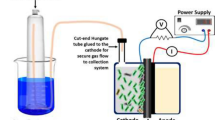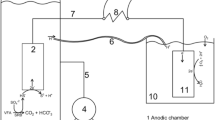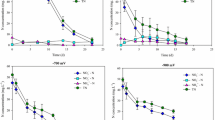Abstract
Microbial electrolysis cells (MECs) have rapidly developed into a promising technology to treat sulfate-rich wastewater that lacks electron donors. Hence, a better understanding of the effect on the microbial community structure caused by different sources in bioelectrochemical systems is required. This study sought to investigate the effect of different carbon sources (NaHCO3, ethanol, and acetate were employed as sole carbon source respectively) on the performance of sulfate-reducing biocathodes. The sulfate reduction efficiency enhanced by the bioelectrochemical systems was 8.09 − 11.57% higher than that of open-circuit reference experiments. Furthermore, the optimum carbon source was ethanol with a maximum sulfate reduction rate of 170 mg L−1 d−1 in the bioelectrochemical systems. The different carbon sources induced significant differences in sulfate reduction efficiency as demonstrated by the application of a micro-electrical field. Microbial community structure and network analysis revealed that all three kinds of carbon source systems enriched large proportions of sulfate-reducing bacteria and electroactive bacteria but were significantly distinct in composition. The dominant sulfate-reducing bacteria that use NaHCO3 and acetate as carbon sources were Desulfobacter and Desulfobulbus, whereas those that use ethanol as carbon source were Desulfomicrobium and Desulfovibrio. Our results suggest that ethanol is a more suitable carbon source for sulfate reduction in bioelectrochemical systems.
Graphical abstract







Similar content being viewed by others
Data availability
All data generated or analyzed during this study are included in this published article.
References
Ailijiang N, Chang JL, Liang P, Li P, Wu Q, Zhang XY, Huang X (2016) Electrical stimulation on biodegradation of phenol and responses of microbial communities in conductive carriers supported biofilms of the bioelectrochemical reactor. Bioresour Technol 201:1–7. https://doi.org/10.1016/j.biortech.2015.11.026
Blázquez E, Gabriel D, Baeza JA, Guisasola A (2016) Treatment of high-strength sulfate wastewater using an autotrophic biocathode in view of elemental sulfur recovery. Water Res 105:395–405. https://doi.org/10.1016/j.watres.2016.09.014
Blázquez E, Gabriel D, Baeza JA, Guisasola A (2017) Evaluation of key parameters on simultaneous sulfate reduction and sulfide oxidation in an autotrophic biocathode. Water Res 123:301–310. https://doi.org/10.1016/j.watres.2017.06.050
Blázquez E, Baeza JA, Gabriel D, Guisasola A (2019) Treatment of real flue gas desulfurization wastewater in an autotrophic biocathode in view of elemental sulfur recovery: Microbial communities involved. Sci Total Environ 657:945–952. https://doi.org/10.1016/j.scitotenv.2018.12.037
Brandt KK, Ingvorsen K (1997) Desulfobacter halotolerans sp. nov., a halotolerant acetate-oxidizing sulfate-reducing bacterium isolated from sediments of great salt lake. Utah Syst Appl Microbiol 20:366–373. https://doi.org/10.1016/S0723-2020(97)80004-5
Cao JY, Zhang GJ, Mao ZS, Li YY, Fang ZH, Yang C (2012) Influence of electron donors on the growth and activity of sulfate-reducing bacteria. Int J Miner Process 106–109:58–64. https://doi.org/10.1016/j.minpro.2012.02.005
Castillo J, Pérez-López R, Sarmiento AM, Nieto JM (2012) Evaluation of organic substrates to enhance the sulfate-reducing activity in phosphogypsum. Sci Total Environ 439:106–113. https://doi.org/10.1016/j.scitotenv.2012.09.035
Chen F, Li ZL, Yang JQ, Liang B, Lin XQ, Nan J, Wang AJ (2018) Effects of different carbon substrates on performance, microbiome community structure and function for bioelectrochemical-stimulated dechlorination of tetrachloroethylene. Chem Eng J 352:730–736. https://doi.org/10.1016/j.cej.2018.07.082
Chen F, Li ZL, Liang B, Yang JQ, Cheng HY, Huang C, Nan J, Wang AJ (2019a) Electrostimulated bio-dechlorination of trichloroethene by potential regulation: Kinetics, microbial community structure and function. Chem Eng J 357:633–640. https://doi.org/10.1016/j.cej.2018.09.191
Chen F, Liang B, Li ZL, Yang JQ, Huang C, Lyu M, Yuan Y, Nan J, Wang AJ (2019b) Bioelectrochemical assisted dechlorination of tetrachloroethylene and 1,2-dichloroethane by acclimation of anaerobic sludge. Chemosphere 227:514–521. https://doi.org/10.1016/j.chemosphere.2019.04.066
Chen F, Li ZL, Lv M, Huang C, Liang B, Yuan Y, Lin XQ, Gao XY, Wang AJ (2020a) Recirculation ratio regulates denitrifying sulfide removal and elemental sulfur recovery by altering sludge characteristics and microbial community composition in an EGSB reactor. Environ Res 181:108905. https://doi.org/10.1016/j.envres.2019.108905
Chen X, Zheng LG, Dong XL, Jiang CL, Wei XP (2020) Sources and mixing of sulfate contamination in the water environment of a typical coal mining city, China: evidence from stable isotope characteristics. Environ Geochem Hlth 42:2865–2879. https://doi.org/10.1007/s10653-020-00525-2
Chen F, Mote SR, Li ZL, Ye Y, Lv M, Liang B, Yuan Y, Chen HY, Liu Y, He ZW, Wang HC, Wang Y, Wang AJ (2022) Coupled sulfur and electrode-driven autotrophic denitrification for significantly enhanced nitrate removal. Water Res 220:118675. https://doi.org/10.1016/j.watres.2022.118675
Cheng HY, Tian XD, Li CH, Wang SS, Su SG, Wang HC, Zhang B, Sharif HMA, Wang AJ (2017) Microbial photoelectrotrophic denitrification as a sustainable and efficient way for reducing nitrate to nitrogen. Environ Sci Technol 51(21):12948–12955. https://doi.org/10.1021/acs.est.7b02557
Eaktasang N, Kang CS, Lim H, Kwean OS, Cho S, Kim Y, Kim HS (2016) Production of electrically-conductive nanoscale filaments by sulfate-reducing bacteria in the microbial fuel cell. Bioresour Technol 210:61–67. https://doi.org/10.1016/j.biortech.2015.12.090
Gao S, Li ZL, Hou YA, Wang AJ, Liu Q, Huang C (2022) Effects of different carbon sources on the efficiency of sulfur-oxidizing denitrifying microorganisms. Environ Res 204:111946. https://doi.org/10.1016/j.envres.2021.111946
Guo WR, Wen Y, Chen Y, Zhou Q (2020) Sulfur cycle as an electron mediator between carbon and nitrate in a constructed wetland microcosm. Front Env Sci Eng 14:57. https://doi.org/10.1007/s11783-020-1236-y
Hao TW, Xiang PY, Mackey HR, Chi K, Lu H, Chui HK, van Loosdrecht MCM, Chen GH (2014) A review of biological sulfate conversions in wastewater treatment. Water Res 65:1–21. https://doi.org/10.1016/j.watres.2014.06.043
Hu JP, Zeng CP, Liu GL, Luo HP, Qu L, Zhang RD (2018) Magnetite nanoparticles accelerate the autotrophic sulfate reduction in biocathode microbial electrolysis cells. Biochem Eng J 133:96–105. https://doi.org/10.1016/j.bej.2018.01.036
Hu J, Zeng CP, Liu GL, Lu YB, Zhang RD, Luo HP (2019) Enhanced sulfate reduction accompanied with electrically-conductive pili production in graphene oxide modified biocathodes. Bioresour Technol 282:425–432. https://doi.org/10.1016/j.biortech.2019.03.023
Hurtado C, Viedma P, Cotoras D (2018) Design of a bioprocess for metal and sulfate removal from acid mine drainage. Hydrometallurgy 180:72–77. https://doi.org/10.1016/j.hydromet.2018.07.006
Hwang SK, Jho EH (2018) Heavy metal and sulfate removal from sulfate-rich synthetic mine drainages using sulfate reducing bacteria. Sci Total Environ 635:1308–1316. https://doi.org/10.1016/j.scitotenv.2018.04.231
Lakaniemi AM, Nevatalo LM, Kaksonen AH, Puhakka JA (2010) Mine wastewater treatment using Phalaris arundinacea plant material hydrolyzate as substrate for sulfate-reducing bioreactor. Bioresour Technol 101:3931–3939. https://doi.org/10.1016/j.biortech.2010.01.020
Liamleam W, Annachhatre AP (2007) Electron donors for biological sulfate reduction. Biotechnol Adv 25:452–463. https://doi.org/10.1016/j.biotechadv.2007.05.002
Liang FY, Xiao Y, Zhao F (2013) Effect of pH on sulfate removal from wastewater using a bioelectrochemical system. Chem Eng J 218:147–153. https://doi.org/10.1016/j.cej.2012.12.021
Liang B, Cheng HY, Van Nostrand JD, Ma J, Yu H, Kong D, Liu WZ, Ren NQ, Wu LY, Wang AJ, Lee DJ, Zhou JZ (2014) Microbial community structure and function of Nitrobenzene reduction biocathode in response to carbon source switchover. Water Res 54:137–148. https://doi.org/10.1016/j.watres.2014.01.052
Lin R, Cheng J, Zhang JB, Zhou JH, Cen K, Murphy JD (2017) Boosting biomethane yield and production rate with graphene: The potential of direct interspecies electron transfer in anaerobic digestion. Bioresour Technol 239:345–352. https://doi.org/10.1016/j.biortech.2017.05.017
Liu QQ, Sheng YQ, Wang WJ, Li CY, Zhao GQ (2020) Remediation and its biological responses of Cd contaminated sediments using biochar and minerals with nanoscale zero-valent iron loading. Sci Total Environ 713:136650. https://doi.org/10.1016/j.scitotenv.2020.136650
Luo HP, Fu SY, Liu GL, Zhang RD, Bai YP, Luo XN (2014) Autotrophic biocathode for high efficient sulfate reduction in microbial electrolysis cells. Bioresour Technol 167:462–468. https://doi.org/10.1016/j.biortech.2014.06.058
Luo HP, Teng WK, Liu GL, Zhang RD, Lu YB (2017) Sulfate reduction and microbial community of autotrophic biocathode in response to acidity. Process Biochem 54:120–127. https://doi.org/10.1016/j.procbio.2016.12.025
Murphy CL, Biggerstaff J, Eichhorn A, Ewing E, Shahan R, Soriano D, Stewart S, VanMol K, Walker R, Walters P, Elshahed MS, Youssef NH (2021) Genomic characterization of three novel Desulfobacterota classes expand the metabolic and phylogenetic diversity of the phylum. Environ Microbiol 23:4326–4343. https://doi.org/10.1111/1462-2920.15614
Nagpal S, Chuichulcherm S, Livingston A, Peeva L (2000) Ethanol utilization by sulfate-reducing bacteria: an experimental and modeling study. Biotechnol Bioeng 70(5):533–543. https://doi.org/10.1002/1097-0290(20001205)70:5%3c533::AID-BIT8%3e3.0.CO;2-C
Nascimento AL, Souza AJ, Andrade PAM, Andreote FD, Coscione AR, Oliveira FC, Regitano JB (2018) Sewage sludge microbial structures and relations to their sources, treatments, and chemical attributes. Front Microbiol 9:165–181. https://doi.org/10.3389/fmicb.2018.01462
Nogueira EW, Licona FM, Godoi LAG, Brucha G, Damianovic MHRZ (2019) Biological treatment removal of rare earth elements and yttrium (REY) and metals from actual acid mine drainage. Water Sci Technol 80(8):1485–1493. https://doi.org/10.2166/wst.2019.398
Nogueira EW, Godoi LAG, Yabuki LNM, Yabuki LNM, Brucha G, Damianovic MHRZ (2021) Sulfate and metal removal from acid mine drainage using sugarcane vinasse as electron donor: performance and microbial community of the down-flow structured-bed bioreactor. Bioresour Technol 330:124968. https://doi.org/10.1016/j.biortech.2021.124968
Pozo G, Pongy S, Keller J, Ledezma P, Freguia S (2017) A novel bioelectrochemical system for chemical-free permanent treatment of acid mine drainage. Water Res 126:411–420. https://doi.org/10.1016/j.watres.2017.09.058
Rago L, Guerrero J, Baeza JA, Guisasola A (2015) 2-Bromoethanesulfonate degradation in bioelectrochemical systems. Bioelectrochemistry 105:44–49. https://doi.org/10.1016/j.bioelechem.2015.05.001
Reyes-Alvarado LC, Okpalanze NN, Rene ER, Rustrian E, Houbron E, Esposito G, Lens PNL (2017) Carbohydrate based polymeric materials as slow release electron donors for sulphate removal from wastewater. J Environ Manage 200:407–415. https://doi.org/10.1016/j.jenvman.2017.05.074
Rotaru AE, Shrestha PM, Liu FH, Shrestha M, Shrestha D, Embree M, Zengler K, Wardman C, Nevin KP, Lovley DR (2014) A new model for electron flow during anaerobic digestion: direct interspecies electron transfer to Methanosaeta for the reduction of carbon dioxide to methane. Energ Environ Sci 7(1):408–415. https://doi.org/10.1039/C3EE42189A
Sampaio GF, Santos AM, Costa PR, Rodriguez RP, Sancinetti GP (2019) High rate of biological removal of sulfate, organic matter, and metals in UASB reactor to treat synthetic acid mine drainage and cheese whey wastewater as carbon source. Water Environ Res 92(2):245–254. https://doi.org/10.1002/wer.1235
Sarti A, Zaiat M (2011) Anaerobic treatment of sulfate-rich wastewater in an anaerobic sequential batch reactor (AnSBR) using butanol as the carbon source. J Environ Manage 92:1537–1541. https://doi.org/10.1016/j.jenvman.2011.01.009
Shi K, Cheng WM, Jiang Q, Xue JL, Qiao YL, Cheng DB (2022) Insight of the bio-cathode biofilm construction in microbial electrolysis cell dealing with sulfate-containing wastewater. Bioresour Technol 361:127695. https://doi.org/10.1016/j.biortech.2022.127695
Srivastava P, Abbassi R, Yadav A, Garaniya V, Asadnia M, Lewis T, Khan SJ (2021) Influence of applied potential on treatment performance and clogging behaviour of hybrid constructed wetland-microbial electrochemical technologies. Chemosphere 284:131296. https://doi.org/10.1016/j.chemosphere.2021.131296
Sun RR, Zhang L, Zhang ZF, Chen GH, Jiang F (2018) Realizing high-rate sulfur reduction under sulfate-rich conditions in a biological sulfide production system to treat metal-laden wastewater deficient in organic matter. Water Res 131:239–245. https://doi.org/10.1016/j.watres.2017.12.039
Sun Y, Qaisar M, Wang KQ, Chen BL, Cai J (2021) Validation of effective role of substrate concentrations on elemental sulfur generation in simultaneous sulfide and nitrate removal process. Sep Purif Technol 268:118698. https://doi.org/10.1016/j.seppur.2021.118698
Tang Q, Sheng YQ, Li CY, Wang WJ, Liu XZ (2020) Simultaneous removal of nitrate and sulfate using an up-flow three-dimensional biofilm electrode reactor: performance and microbial response. Bioresour Technol 318:124096. https://doi.org/10.1016/j.biortech.2020.124096
Teng WK, Liu GL, Luo HP, Zhang RD, Xiang YB (2016) Simultaneous sulfate and zinc removal from acid wastewater using an acidophilic and autotrophic biocathode. J Hazard Mater 304:159–165. https://doi.org/10.1016/j.jhazmat.2015.10.050
Thauer RK, Jungermann K, Decker K (1977) Energy conservation in chemotrophic anaerobic bacteria. Bacteriol Rev 41(1):100–180. https://doi.org/10.1128/br.41.1.100-180.1977
Wang K, Cao ZQ, Chang JJ, Sheng YX, Cao HB, Yan KP, Zhang Y, Xia Z (2017a) Promoted bioelectrocatalytic activity of microbial electrolysis cell (MEC) in sulfate removal through the synergy between neutral red and graphite felt. Chem Eng J 327:183–192. https://doi.org/10.1016/j.cej.2017.06.086
Wang K, Sheng YX, Cao HB, Yan KP, Zhang Y (2017b) Impact of applied current on sulfate-rich wastewater treatment and microbial biodiversity in the cathode chamber of microbial electrolysis cell (MEC) reactor. Chem Eng J 307:150–158. https://doi.org/10.1016/j.cej.2016.07.106
Wiessner A, Rahman KZ, Kuschk P, Kästner M, Jechorek M (2010) Dynamics of sulphur compounds in horizontal sub-surface flow laboratory-scale constructed wetlands treating artificial sewage. Water Res 44:6175–6185. https://doi.org/10.1016/j.watres.2010.07.044
Xia D, Yi XY, Lu Y, Huang WL, Xie YY, Ye H, Dang Z, Tao XQ, Li L, Lu GN (2019) Dissimilatory iron and sulfate reduction by native microbial communities using lactate and citrate as carbon sources and electron donors. Ecotox Environ Safe 174:524–531. https://doi.org/10.1016/j.ecoenv.2019.03.005
Xiang YB, Liu GL, Zhang RD, Lu YB, Luo HP (2017) Acetate production and electron utilization facilitated by sulfate-reducing bacteria in a microbial electrosynthesis system. Bioresour Technol 241:821–829. https://doi.org/10.1016/j.biortech.2017.06.017
Xing LZ, Zhang WK, Gu MQ, Yin QD, Wu GX (2020) Microbial interactions regulated by the dosage of ferroferric oxide in the co-metabolism of organic carbon and sulfate. Bioresour Technol 296:122317. https://doi.org/10.1016/j.biortech.2019.122317
Xu XJ, Chen C, Guan X, Yuan Y, Wang AJ, Lee DJ, Zhang ZF, Zhang J, Zhong YJ, Ren NQ (2017) Performance and microbial community analysis of a microaerophilic sulfate and nitrate co-reduction system. Chem Eng J 330:63–70. https://doi.org/10.1016/j.cej.2017.07.136
Xu H, Tong N, Huang SB, Zhou SF, Li S, Li JJ, Zhang YQ (2018a) Degradation of 2,4,6-trichlorophenol and determination of bacterial community structure by micro-electrical stimulation with or without external organic carbon source. Bioresour Technol 263:266–272. https://doi.org/10.1016/j.biortech.2018.05.015
Xu ZS, Dai XH, Chai XL (2018b) Effect of different carbon sources on denitrification performance, microbial community structure and denitrification genes. Sci Total Environ 634:195–204. https://doi.org/10.1016/j.scitotenv.2018.03.348
Yildiz M, Yilmaz T, Arzum CS, Yurtsever A, Kaksonen AH, Ucar D (2019) Sulfate reduction in acetate- and ethanol-fed bioreactors: acidic mine drainage treatment and selective metal recovery. Miner Eng 133:52–59. https://doi.org/10.1016/j.mineng.2019.01.007
Yuan Y, Cheng HY, Chen F, Zhang YQ, Xu XJ, Huang C, Chen C, Liu WZ, Ding C, Li ZX, Chen TM, Wang AJ (2020) Enhanced methane production by alleviating sulfide inhibition with a microbial electrolysis coupled anaerobic digestion reactor. Environ Int 136:105503. https://doi.org/10.1016/j.envint.2020.105503
Zhang YP, Li GQ, Wen J, Xu YG, Sun J, Ning XA, Lu XW, Wang YJ, Yang ZY, Yuan Y (2018) Electrochemical and microbial community responses of electrochemically active biofilms to copper ions in bioelectrochemical systems. Chemosphere 196:377–385. https://doi.org/10.1016/j.chemosphere.2018.01.009
Zhou JJ, Liang X, Luo J, Chen WW, Liu JR (2020) Effects of sulfate on activated sludge characteristics and membrane fouling in membrane bioreactor treating penicillin wastewater. J Water Process Eng 38:101594. https://doi.org/10.1016/j.jwpe.2020.101594
Acknowledgements
The authors would like to thank the editor and reviewers for their contributions to improving the quality of this paper.
Funding
This work was financially supported by the Natural Science Foundation of the Jiangsu Higher Education Institutions of China [19KJB610027] as well as the Graduate Research Innovation Program of Yancheng Institute of Technology (KYCX21_XZ2004).
Author information
Authors and Affiliations
Contributions
Tian-ming Chen conceived and designed the studies. Jing-jing Pan drafted the manuscript. Xiang-yang Cao and Jun Huang performed the studies. Lu-yu Tan and Yu-kang Gu contributed in the data collection. Qing-qing Fan contributed in the data analysis. Tian-ming Chen contributed in the provision of ideas of this manuscript. All authors have read and approved the final manuscript.
Corresponding author
Ethics declarations
Ethics approval and consent to participate
Not applicable.
Consent for publication
Not applicable.
Conflict of interest
The authors declare no competing interests.
Additional information
Responsible Editor: Diane Purchase
Publisher's note
Springer Nature remains neutral with regard to jurisdictional claims in published maps and institutional affiliations.
Supplementary Information
Below is the link to the electronic supplementary material.
Rights and permissions
Springer Nature or its licensor holds exclusive rights to this article under a publishing agreement with the author(s) or other rightsholder(s); author self-archiving of the accepted manuscript version of this article is solely governed by the terms of such publishing agreement and applicable law.
About this article
Cite this article
Pan, Jj., Tan, Ly., Fan, Qq. et al. Effect of different carbon sources on sulfate reduction and microbial community structure in bioelectrochemical systems. Environ Sci Pollut Res 30, 18312–18324 (2023). https://doi.org/10.1007/s11356-022-23487-7
Received:
Accepted:
Published:
Issue Date:
DOI: https://doi.org/10.1007/s11356-022-23487-7




